Lifting Summer Bulbs for Winter Storage
Posted by Amaya Fairbanks on Oct 5th 2025
Lifting Summer Bulbs for Winter Storage
Summer bulbs are also known as tender bulbs, and are planted for those hot-weather showstopper blooms. Tender bulbs is a general term that includes true bulbs, corms, tubers, rhizomes, and tuberous roots. They need to be lifted each fall as they are not sufficiently hardy to survive the extreme winter temperatures in Minnesota. Tender bulbs include Amaryllis, Canna, Gladiolus, Dahlia, Colocasia (elephant ears), Caladium, Calla Lilies, and Begonias.
Dig or lift tender bulbs
Dig up tender bulbs in the fall after foliage turns yellow, dries up, or is killed by a hard frost. Loosen roots/tubers gently with a garden fork or spade by digging several inches away from the base of the plant. When digging up large plants (Cannas or Dahlias), you can also cut 6 inches above their base and discard foliage to create easier access to tubers. Be sure to use clean (sanitized) tools when cutting foliage, as disease can easily contaminate plants late in the fall.
Clean bulbs and tubers
Cleaning practices may vary. Gently wash Dahlias and Cannas with a garden hose to remove any dirt. Gladiolus, Begonias, and Caladium can be gently brushed clean.
Cure or dry tender bulbs, then divide
The typical drying period for Dahlias and Cannas is one to three days, and should be done inside. It is important that curing be done in a temperature controlled area away from sun or wind. After dry, you may choose to divide tubers.
Cannas are easily split where pups have grown attached to the mother bulb. They will cure or scab along division points.
Dahlias can be divided with a clean pair of shears or sharp scissors. Each tuber can be separated as long as it has a piece of the main stem. Each individual tuber will need an eye to produce in the spring. It can be difficult to identify each eye on tubers in the fall, but they will become more visible in the spring and may even begin to push a green shoot. Good practice is to save all tubers and discard any that lack eyes in the spring.
Gladiolus may require a long term cure which can take up to three weeks.
Elephant Ears may also require a longer cure time. If any rot is evident, they should be discarded.
Label bulbs
Labeling is important at this stage. You can write directly on the bulb or tuber with a felt marker, or you may prefer to tie labels to roots or tubers. Adding cultivar names and possibly important characteristics (height, bloom ratio, or color identifiers) is a good idea to help you keep track of where you might want to plant them. If you are really dedicated, you may decide to keep a spreadsheet and update that each year!
Store tender bulbs and tubers
Storing methods vary by type of plant. It is advisable to only store healthy bulbs or tubers at this point. Most tender bulbs and tubers need to be stored in cool, dry conditions with temperatures between 40F-50F. Avoid sunlight and drastic temperature swings.
Dahlias are best stored wrapped in plastic wrap. This method is advised by the National Dahlia Society. Roll each individual tuber in plastic wrap, adding another tuber of the same type as you go. The layers of plastic wrap keep the tubers from drying out, and also ensure that if one tuber rots that it will not affect the others. Label each bunch and store them in an open box or paper bag in a cool basement, closet, or pantry. Do not store them in the garage unless it is temperature controlled.
Store Elephant Ears, Cannas, and Calla bulbs in vermiculite or saw dust in an open box or paper bag. These are best kept in a cool room in a basement or pantry.
Begonias should be gently brushed free of dirt and stored in a paper bag.
Always growing
If you are new to lifting bulbs, alway ask questions. We are here to help! Feel free to stop in-store, give us a call at (952) 938-6480, or email us: hello@tonkadale.com.

